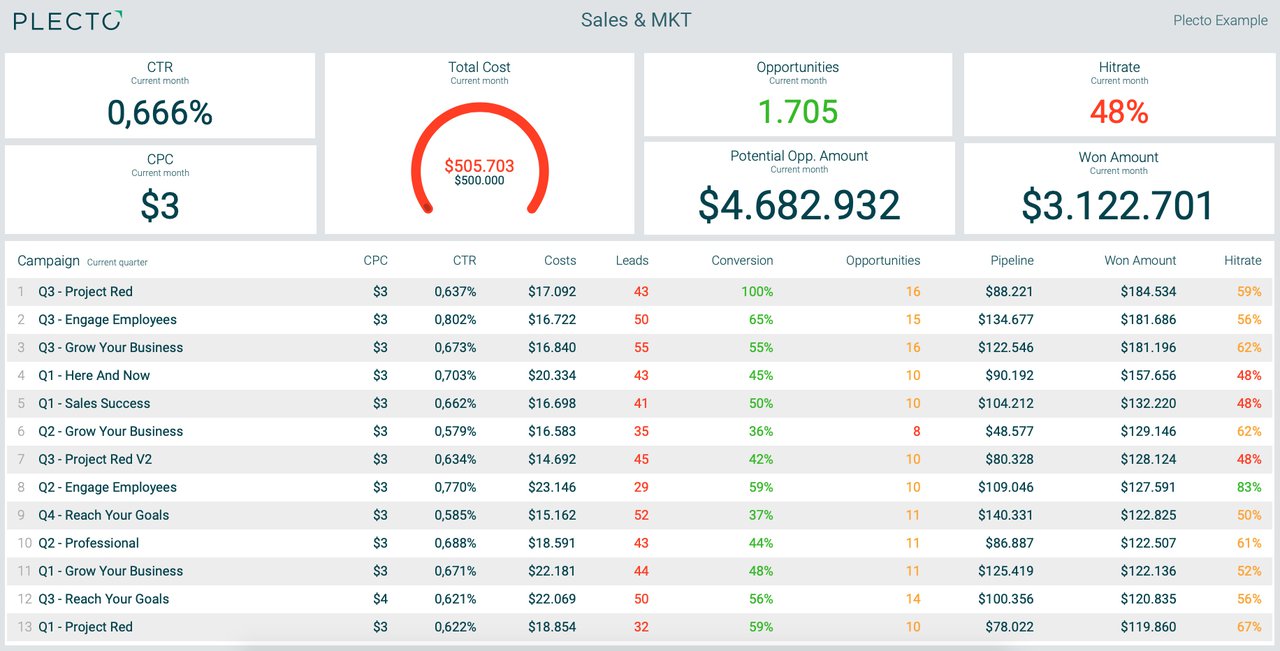It doesn’t matter if it’s an open office, a remote-working company, or a multi-department organization, truth is that the Marketing department is usually the one with the highest uncertainty among the rest.
And the main reason for this is that many results from the marketing initiatives can’t be tracked as accurately and numerically as the other departments. They don’t talk about Amount of Sales, Churn Rate, or Meetings Booked in the Marketing meetings. They talk about customers’ engagement and value creation. What’s the equation for that?
However, although KPIs are usually very different between the Marketing and Sales team, they usually are more related than what we might think. Do you know what are the benefits of bringing these two teams together?
Research by Aberdeen, for instance, showed that companies with a strong alignment between sales and marketing reach a 20% annual growth rate. However, only 8% of companies actually work on this alignment.
We want to change these statistics by simplifying the process of bringing the Marketing and Sales departments together because we’ve seen what this collaboration can mean for the business!
Because we believe that best practices should be shared, we have created a 3-steps guide for you to easily promote a successful and insightful collaboration between these two amazing teams! And hopefully, make it a healthy habit for your business.
1. Let’s meet each other
Well, it might sound weird, but we’ve noticed that not many Sales teams know what is on the Marketing department’s plate at the moment, and also vice versa. Maybe because both departments have different methods, objectives, or approaches to the customer.
But, at the same time, they are both working towards the same company’s goals. So let’s introduce them then! How far can they really be from each other?
Typically, the Marketing department creates content to bring leads to the website, where they can find more content specific to their needs, as well as the introduction to the product. If they like what they see, and it fits with what they were looking for, they will most likely sign up for the trial.
And that’s where the marketers pass on the torch to your salespeople, who are in charge of contacting those leads and hopefully turning them into actual costumers.
You can start by bringing both Marketing and Sales Managers together in a meeting, to set the bases and objectives for the collaboration. But you should count on a further presentation for both teams so that they are all on the same page.
The goal of this data-driven collaboration is that both teams can get great insights from each other to orient their initiatives more accurately. Therefore, if Marketing is aware of the sales team’s objectives for this month, they can join forces and point in the same direction.
For instance, if your salespeople are focusing on getting more enterprise customers at the moment, your marketers can also decide to focus on creating content specifically for them, as well as investing the budget on their most-used platforms.
Moreover, bringing Marketing and Sales teams together allows them to easily share the feedback they receive, which again can be a great asset when tailoring the monthly strategy and KPIs.

2. Allow them to see their progress
The main purpose is to make this collaboration a habit, to avoid going back to independent departments that don’t share knowledge with each other. Therefore, make sure to promote this teamwork by sharing feedback, data, and tools.
Moreover, you can provide them both with great learnings by showing them last month’s data. This way, they can easily see what worked and what did not, so that they can optimize their approach for the following months.
But they don’t need to wait until the end of the month to get insight into their performance. By working together, they can more quickly understand when something is not working as it was supposed to, or when something needs a quick fix to prevent results from falling.
For instance, imagine that your Marketing team has allocated a higher budget than usual to Linkedin ads, aiming to increase interaction with the enterprise audience. However, already from the first week, your Sales team is receiving more and more sign-ups for trials from startups and freelancers, which affirm to be coming from this same ad. Thanks to this open and close collaboration between these two teams, your marketers can quickly stop the ad from running and reallocate their advertising budget on another platform, in no time!
3. Celebrate joint successful results
As well as we agreed on the higher subjectivity involved in measuring Marketing initiatives with accurate numbers, we usually face the same issue when tracking results.
A lead that converts into a customer is considered a success for the Marketing or the Sales department? Where is the line between one another?
Truth is, once again, that Marketing teams tend to be left in the shadow of Sales and Support teams when it comes to taking credit. Because let’s face it, the last step is what counts… or maybe not?
You can end up this loop by involving all your employees in the company’s successes because that’s what a real team does! All your departments, and employees, are doing their best to reach objectives and fulfill expectations, and that’s what matters.
But words are just words, right? Instead, bring data to the table and allow your team to see for themselves each other’s achievements and the joint progress over time. You can easily start promoting a transparent culture in your company, where data-driven conversations are always an option.
Plus, by sharing your Marketing and Sales achievements with both teams, you are also engaging them in each other’s performance and objectives. If they know what the KPIs, they might also come up with great ideas to boost them based on their own experience.
These are some of the benefits of bringing your Marketing and Sales teams together, what are you waiting for?




